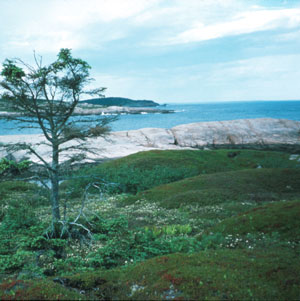DACF Home → Bureaus & Programs → Maine Natural Areas Program → Communities, Plants, and Animals → Natural Community Fact Sheets → Maritime Slope Bog
Printer Friendly Fact Sheet - 1.4 MB pdf (Get a free copy of Adobe Acrobat Reader)
Maritime Slope Bog
Scientific Name: Heath - Crowberry Maritime Slope Bog; State Rank: S2

- Community Description
- Soil and Site Characteristics
- Diagnostics
- Similar Types
- Conservation, Wildlife and Management Considerations
- Distribution
- Characteristic Plants
- Associated Rare Plants
- Associated Rare Animals
- Examples on Conservation Lands You Can Visit
Community Description: A well developed layer of dwarf shrubs is dominated by heath shrubs and black crowberry in a dense carpet. There may be scattered small conifers and typically at least a small amount of common juniper. Baked apple-berry is diagnostic and is restricted to this type and other coastal or subalpine peatlands. Herbaceous “bog” species (deer-hair sedge, pitcher plant, etc.) are also common. The bryoid layer is extensive (>70% cover, usually close to 100%) and is dominated by peat mosses and small islands of reindeer lichens. Back to top.
Soil and Site Characteristics: Sometimes called “blanket bogs”, these occur on bedrock or other rocky substrate. Soil is a thin organic layer over rock, and slopes are usually 5-10%. Sites occur on cool microsites near the Downeast coast. Back to top.
Diagnostics: Tree cover is less than 25% and heath shrubs are dominant. Although the ground layer is composed of peat mosses, peat forms only a thin layer over bedrock or mineral substrate, so this is not a true peatland type. Back to top.
Similar Types: Dwarf Shrub Bogs and Maritime Huckleberry Bogs share species and structure with Maritime Slope Bogs; however, those are found in true peatlands (basins with deep accumulations of saturated peat), not on thin peat over rock. Subalpine Hanging Bogs are compositionally similar but occur in the mountains. Back to top.
Conservation, Wildlife and Management Considerations: This is an extremely restricted community type, but most documented occurrences are on public lands or private conservation lands. Recreation and climate change are the primary threats; careful planning of trails and ensuring that users stay on trails can help minimize recreational impacts.
The rare crowberry blue butterfly is restricted to coastal heaths in east-coastal Maine. It is uses black crowberry as a larval host plant. Back to top.
Distribution: Downeast coastal Maine, extending eastward into the Canadian Maritimes (Laurentian Mixed Forest Province). Landscape Pattern: Small Patch. Back to top.


Characteristic Plants: These plants are frequently found in this community type. Those with an asterisk are often diagnostic of this community.
- Sapling/shrub
- Black chokeberry
- Common juniper
- Mountain holly
- Wild-raisin
- Dwarf Shrub
- Baked apple-berry
- Black crowberry*
- Black huckleberry
- Labrador tea
- Mountain cranberry
- Rhodora
- Sheep laurel*
- Herb
- Bog goldenrod
- Deer-hair sedge
- Pitcher plant
- Round-leaved sundew
- Starflower
- White beak-rush
- Bryoid
- Bog hair-cap moss
- Grey reindeer-lichen
- Sphagnum mosses*
- Woodland reindeer-lichen
There are no documented rare plants associated with this natural community.
- Crowberry blue
Examples on Conservation Lands You Can Visit
| Example | County |
|---|---|
| Great Wass Island Preserve | Washington Co. |
| Petit Manan Point, Petit Manan National Wildlife Refuge | Washington Co. |